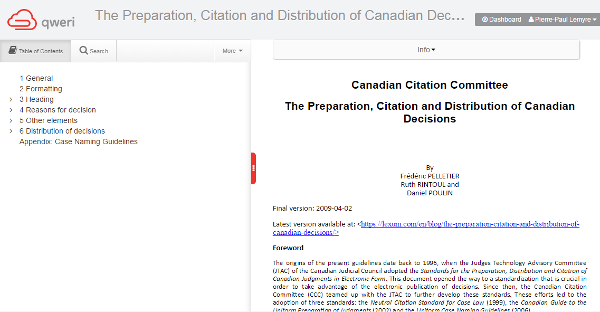Canadian Citation Committee
Final version: 2009-04-02
The origins of the present guidelines date back to 1996, when the Judges Technology Advisory Committee (JTAC) of the Canadian Judicial Council adopted the Standards for the Preparation, Distribution and Citation of Canadian Judgments in Electronic Form.
This document opened the way to a standardization that is crucial in order to take advantage of the electronic publication of decisions. Since then, the Canadian Citation Committee (CCC) teamed up with the JTAC to further develop these standards. These efforts led to the adoption of three standards: the Neutral Citation Standard for Case Law (1999), the Canadian Guide to the Uniform Preparation of Judgments (2002) and the Uniform Case Naming Guidelines (2006).
Canadian courts and tribunals as well as publishers of case law unanimously agree that decisions prepared in accordance with these standards can be disseminated more quickly and at lower costs.
The present guidelines consolidate and modernize the three above-mentioned standards. The consolidation does not put forward major changes to the standards themselves. The few changes that were made reflect the evolution of technology as well as experience from courts, the media and publishers during the implementation of these previous standards. The main goal of the authors is to clarify the applicable standards, better reflect current practices and deal with a few more issues that were previously unaddressed. The most important changes are as follows:
- The concept of “mandatory” and “optional” heading elements is discontinued. All essential elements of information about a decision are included in the “Heading”;
- A wider variety of labels can be used in the heading, as long as they are consistently used in a given court or tribunal;
- The title of the decision is now called “Case name” rather than “Style of cause” or “Short style of cause”. The term “Style of cause” refers to the complete description of the action as found in the heading of a decision;
- A new standard for citing legislative provisions within reasons for decision is introduced allowing courts and tribunals to indicate which version of the legislative provision is being cited;
- A new section on the distribution of decisions is added. It addresses issues such as file naming, how to handle corrected decisions and translations of decisions and what policies and protocols should be developed with respect to the public dissemination of decisions in electronic format.
The authors wish to thank the members of the Canadian Citation Committee, who generously contributed their time and expertise to improve previous versions of this document. A list of current and former CCC members can be found on the CCC website at <https://lexum.com/ccc-ccr/>.
The current and former members of the Judges Technology Advisory Committee of the Canadian Judicial Council are also to be thanked for the guidance and support they have provided for the preparation of the former standards and especially for the present guidelines.
View this document with Qweri.








